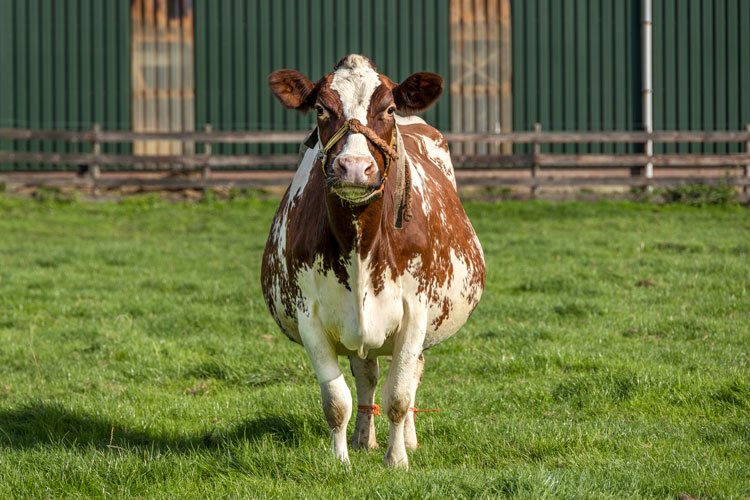Alfalfa hay can be included in prepartum diets |
| By Hay and Forage Grower |
|
|
|
The author is an associate professor and dairy management extension specialist with Virginia Tech University. 
Clinical hypocalcemia, also known as milk fever or periparturient paresis, is a metabolic disease that affects dairy cattle productivity and welfare. This disease occurs around calving when the mammary gland draws calcium from the blood for colostrum secretion immediately after calving. In many cases, the draw of calcium from the blood is sudden; its replenishment to normal levels is not quick enough, and clinical signs like wobbly gait, recumbency, or both occur. Clinical hypocalcemia is a concern for the dairy industry given it can reduce milk production and enhance the risks of other periparturient disorders like metritis, ketosis, and displaced abomasum. One of the few approaches for preventing hypocalcemia is feeding acidogenic products during the prepartum period. Starting to feed acidogenic products about three weeks before the expected calving date decreases the dietary cation-anion difference (DCAD), which induces a metabolic acidosis that stimulates calcium metabolism. Reducing the DCAD to negative values implies that the chemical equivalents of cations like sodium and potassium are less than the chemical equivalents of anions like chloride and sulfur. We primarily want lower concentrations of sodium and potassium and greater concentrations of chloride and sulfur in the diet. Obtaining a desired negative DCAD in prepartum diets can be challenging depending on the forages included, and this challenge mainly relies on the concentration of potassium in the forage. Potassium is the fourth most abundant element in feeds and forages after carbon, hydrogen, and nitrogen, which are the main elements in proteins, lipids, and carbohydrates. Grass hay typically has lower concentrations of potassium than alfalfa hay, so nutritionists commonly avoid including alfalfa hay in prepartum diets. But should they? Alfalfa hay versus grass hay The National Alfalfa and Forage Alliance (NAFA) funded a research project through its Alfalfa Checkoff program in which we challenged the concept of avoiding alfalfa hay when feeding dairy cows in the prepartum period. We hypothesized that prepartum diets containing alfalfa hay can be fed with similar results to feeding prepartum diets containing grass hay. Under this hypothesis, we performed a feeding trial in which we fed 79 dry cows prepartum diets containing either grass hay or alfalfa hay in combination with either calcium chloride or polyhalite as acidogenic products. The diet containing grass hay and calcium chloride is commonly fed at the Virginia Tech Dairy Complex and served as a control diet. We bought and imported the alfalfa hay from the Great Plains, whereas we produced the mixed grass hay on-site at Virginia Tech. All diets contained a DCAD of -190 mEq/kg dry matter (DM) or less, which we considered quite acidic. Cows receiving prepartum diets containing alfalfa hay consumed similar amounts of DM to cows consuming prepartum diets containing grass hay. To determine the effect of feeding prepartum diets with negative DCAD, we measured the pH of animals’ urine before and after feeding the acidogenic diets. The first observation was feeding all diets substantially reduced urinary pH. A second observation was cows consuming alfalfa hay had the lowest urinary pH values. These two observations indicate that we successfully acidified the urine of the cows regardless of the type of hay included in the diet. To evaluate the effect of the diets on hypocalcemia, we sampled animals’ blood and measured its calcium concentration every week during the prepartum period, at calving, and on Days 1, 2, and 3 postcalving. In all cases, the concentration of calcium in blood did not differ, indicating that hay type did not affect hypocalcemia. A final observation was only one of the 79 cows developed hypocalcemia. This cow consumed a diet containing alfalfa hay, but this observation is not significant based on the size of the experiment. Moreover, 12 of the 79 cows had asymptomatic hypocalcemia (plasma calcium concentrations <5.5 mg/dL) at least once between Days 0 and 3 after calving, although no associations existed between diets and the frequency of hypocalcemia. Concentration variations Based on these results, including alfalfa hay in prepartum diets did not harm cattle. In fact, even though the alfalfa hay had a greater concentration of potassium than the grass hay (2.5% and 1.9%, respectively), the alfalfa hay had a DCAD similar to that of the grass hay (292 mEq/kg of DM and 290 mEq/kg of DM, respectively). According to the National Academy of Science, Engineering, and Medicine (NASEM), the DCAD for mature legume hay is 387 mEq/kg of DM and 187 mEq/kg of DM for mature grass hay, which agrees with our original hypothesis of observing a much higher DCAD for alfalfa hay than for grass hay. However, in our study, the DCAD of the alfalfa hay was lower than expected and the DCAD of the grass hay was higher than expected. Beyond the alfalfa hay versus grass hay debate, we learned a few key concepts in this study. The most relevant is rather than the type of forage, the DCAD of a specific forage is critical to determine if it is appropriate to include in prepartum diets. Forage analyses are necessary for this decision. The other takeaway is that the DCAD of the forage might be affected by soil fertility, fertilization choices, or both, although more research is warranted in this. |
